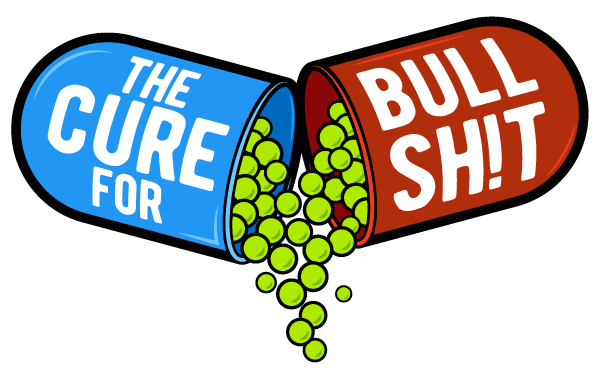The High Cost of Medical Bullshit Part I: Whose Problem Is It Anyway?
Question: is medical bullshit really a big problem? 0r is this campaign against bullshit simply one more attempt for people in mainstream medicine to knock out any competition?
Medical bullshit was not part of my medical training 20 years ago. As far as I know, it is still not part of medical training in most medical schools, although this topic is finally starting to be taken seriously because of the undeniably disastrous consequences of medical misinformation during COVID-19.1-3 In fact, I didn’t really consider medical bullshit as anything more than a fringe issue affecting willfully ignorant blockheads until I finished my training.
It’s important to me that my patients know that it is safe to bring up anything during our visits. This includes use of illicit drugs, skipping medications, taking extra medications, and using supplements or alternative treatments. I was astounded to see how many of my patients were following alternative medical practices, some of which were dangerous and expensive. This included people who were professionals, highly educated, young, old, rich, poor, black, white, and everything in between. It quickly became obvious to me that my assumptions about medical bullshit were wrong and that this was a bigger issue than I had initially thought.
Myth 1: Alternative medicine is a small fringe and mainstream medicine is mainstream.
Truth: 30 to 90% of Americans regularly use some form of alternative medicine depending on who you survey and how broadly you define it. In a study of people living with Parkinson’s at the University of Colorado, the number was 85%.4 Let me also be clear that I am NOT saying all alternative medicine is bullshit – more on this in a later blog.
Myth 2: Intelligent and educated people are immune to medical bullshit.
Truth: While there may be some differences in patterns of which alternative treatments people are most drawn to based on culture, education and socioeconomic status,5 this is a problem that affects truly everyone. A big lesson for me here in seeing some very intelligent people falling for medical scams is that high general intelligence does not equate to high healthcare literacy. And why should it? I don’t expect my medical intelligence to translate to law, mechanics or astronomy.
Myth 3: Medical bullshit is an alternative medicine problem.
Truth: There is plenty of dangerous and expensive bullshit in mainstream medicine. A few examples: the current opiate crisis, which was driven in part by opiates prescribed by physicians;6 use of chemotherapy or other aggressive treatments for cancer patients nearing the end of life who may prefer palliative approaches;7 widespread use of stem cell infusions for osteoarthritis and other conditions without adequate safety or effectiveness data;8 an increasing number of legitimate medical school graduates making careers as celebrity doctors or proponents of illegitimate treatments.9
Myth 4: Other people are dealing with this – it’s not my problem.
Truth: While it would be great if healthcare professionals were better at self-regulating or the FDA did a better job of protecting the public, the fact of the matter is that has always been a problem and likely always will be a problem. There will always be scam artists, true-believers, and variously imperfect physicians. That is why it is so important for us, as citizens, to educate and empower ourselves to cut medical bullshit off at the source. We owe it to society and we owe it to the safety and health of ourselves and those we love.
References:
1. Li HO, Bailey A, Huynh D, Chan J. YouTube as a source of information on COVID-19: a pandemic of misinformation? BMJ Glob Health. 2020;5(5).
2. Abbasi J. COVID-19 Conspiracies and Beyond: How Physicians Can Deal With Patients’ Misinformation. JAMA. 2020.
3. Crawford A, Serhal E. Digital Health Equity and COVID-19: The Innovation Curve Cannot Reinforce the Social Gradient of Health. J Med Internet Res. 2020;22(6):e19361.
4. Finseth TA, Hedeman JL, Brown RP, 2nd, Johnson KI, Binder MS, Kluger BM. Self-reported efficacy of cannabis and other complementary medicine modalities by Parkinson’s disease patients in colorado. Evid Based Complement Alternat Med. 2015;2015:874849.
5. McConnell BV, Applegate M, Keniston A, Kluger B, Maa EH. Use of complementary and alternative medicine in an urban county hospital epilepsy clinic. Epilepsy Behav. 2014;34:73-76.
6. Seth P, Scholl L, Rudd RA, Bacon S. Overdose Deaths Involving Opioids, Cocaine, and Psychostimulants – United States, 2015-2016. MMWR Morb Mortal Wkly Rep. 2018;67(12):349-358.
7. Clark K. Care at the Very End-of-Life: Dying Cancer Patients and Their Chosen Family’s Needs. Cancers (Basel). 2017;9(2).
8. Jones IA, Togashi R, Wilson ML, Heckmann N, Vangsness CT, Jr. Intra-articular treatment options for knee osteoarthritis. Nat Rev Rheumatol. 2019;15(2):77-90.
9. Tilburt JC, Allyse M, Hafferty FW. The Case of Dr. Oz: Ethics, Evidence, and Does Professional Self-Regulation Work? AMA J Ethics. 2017;19(2):199-206.

